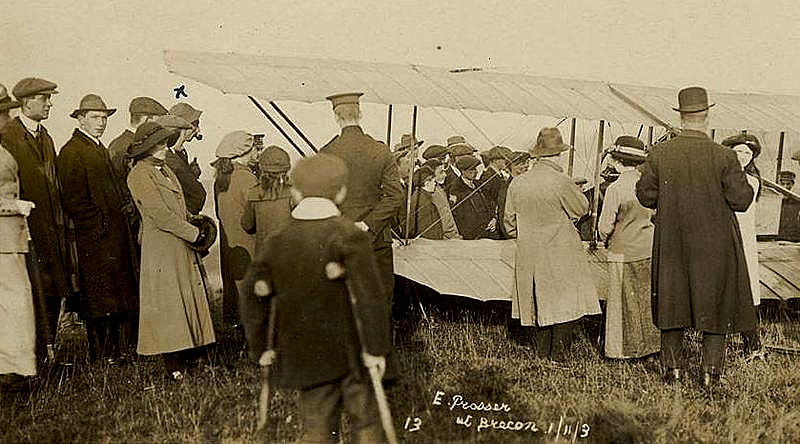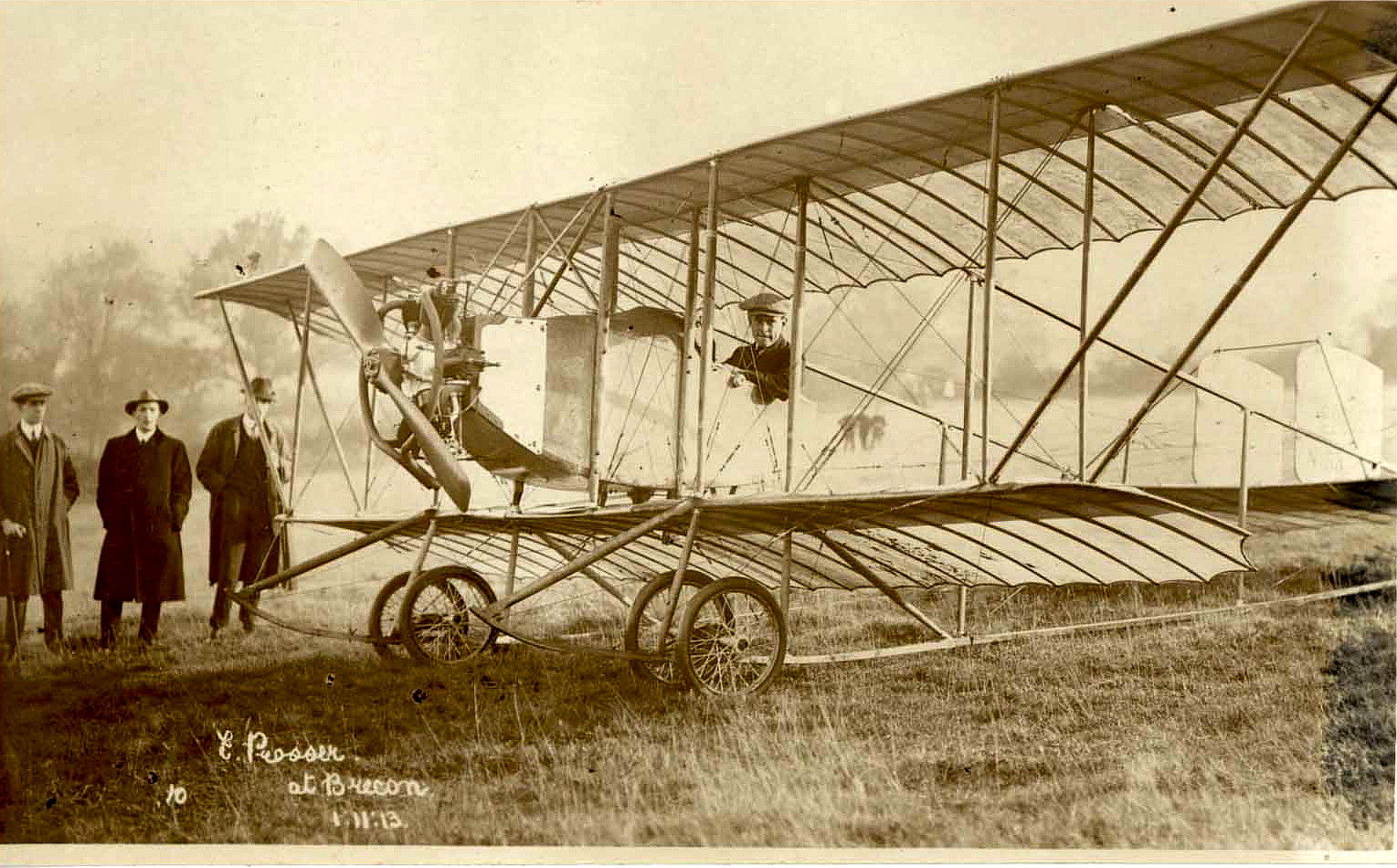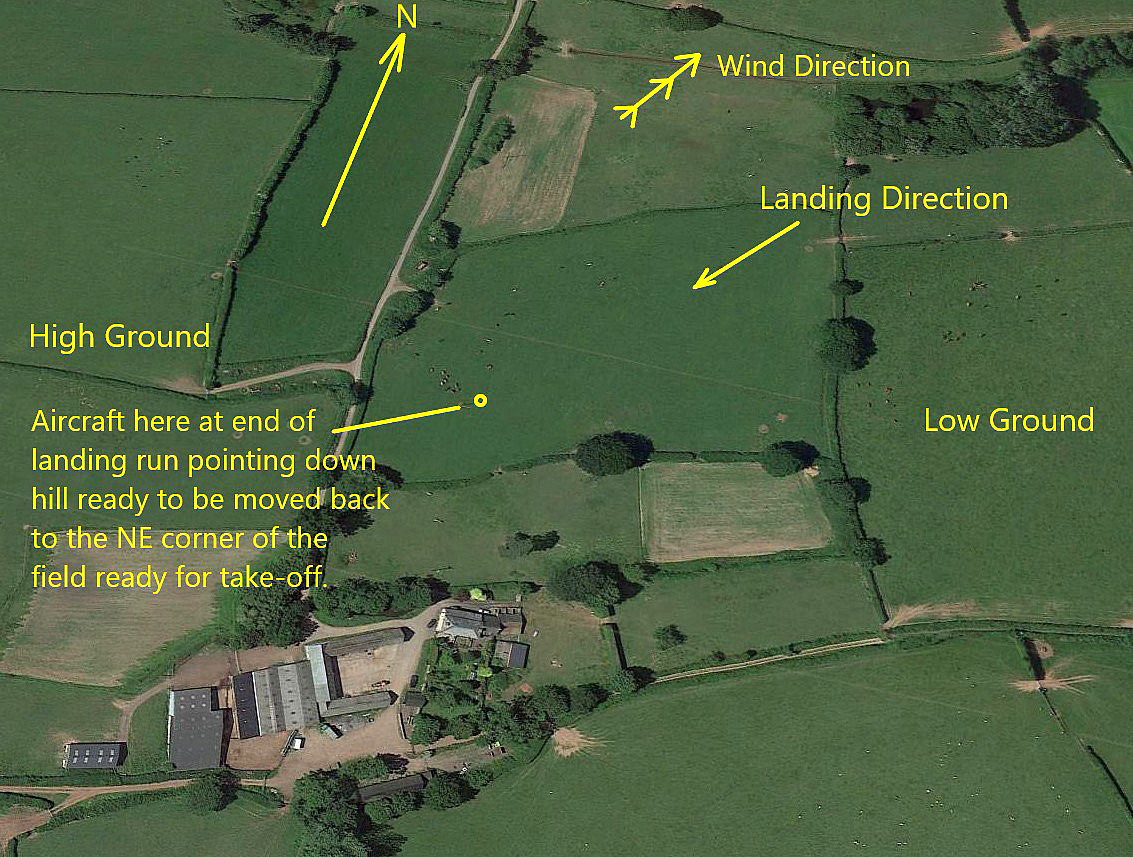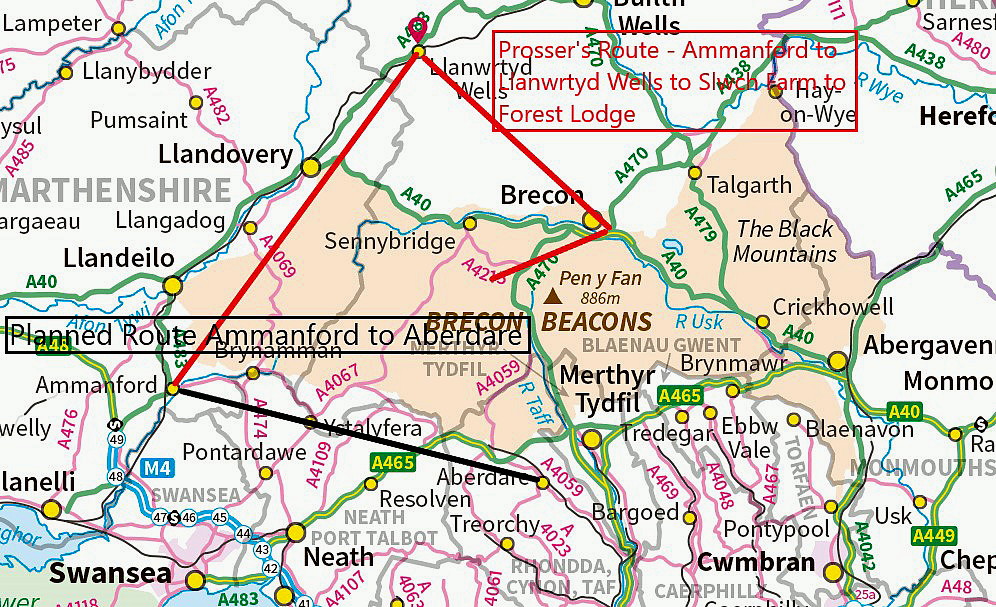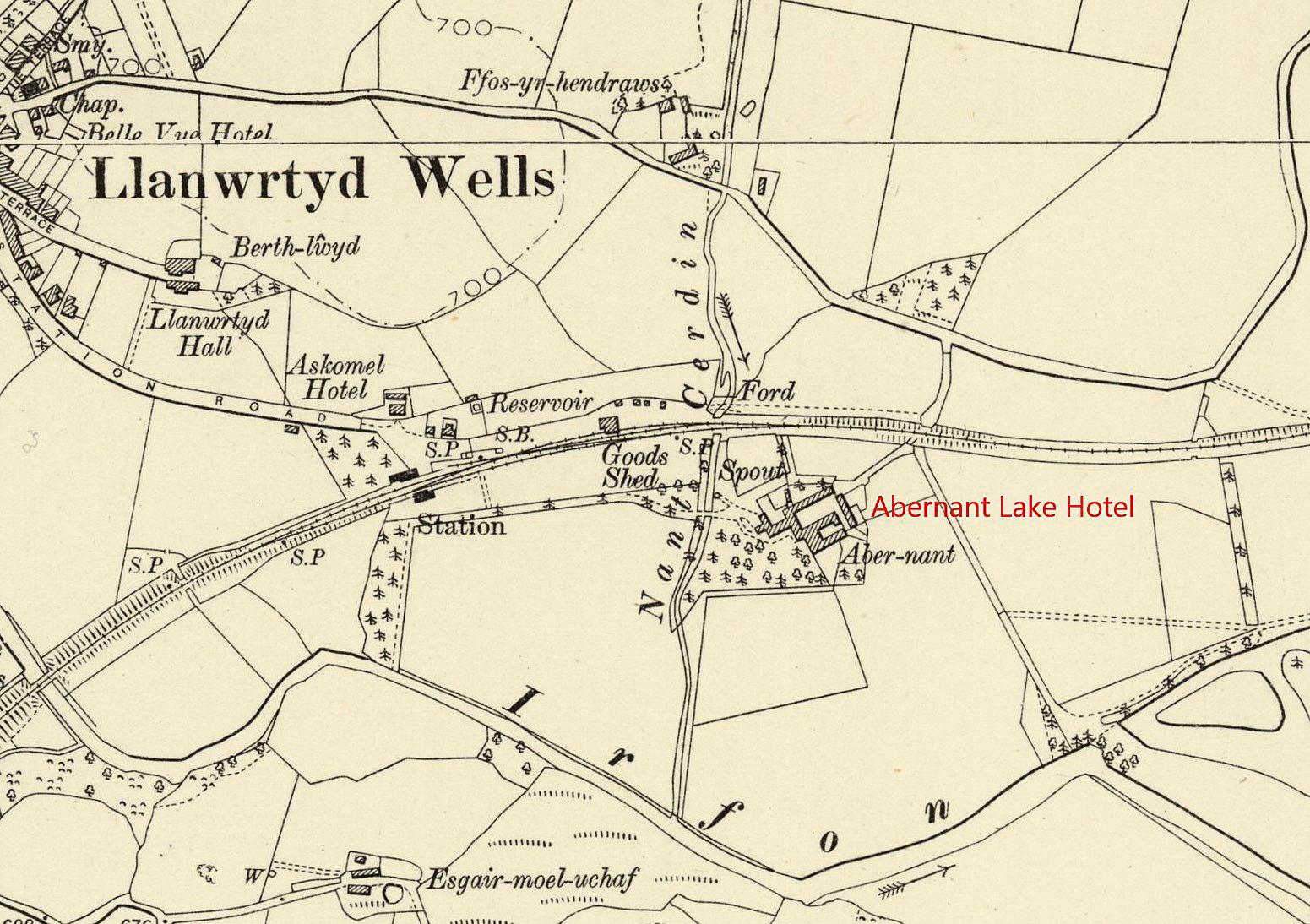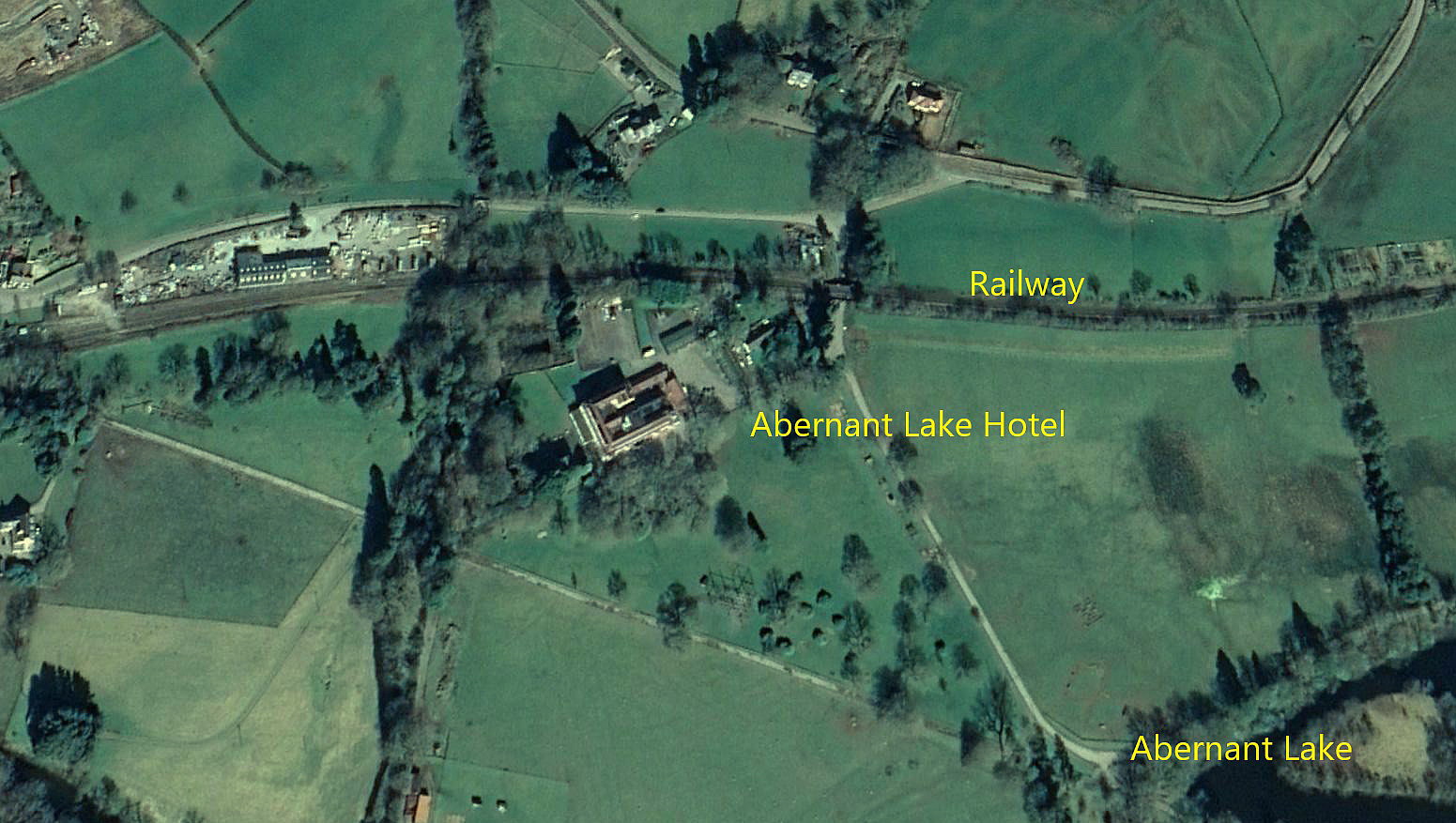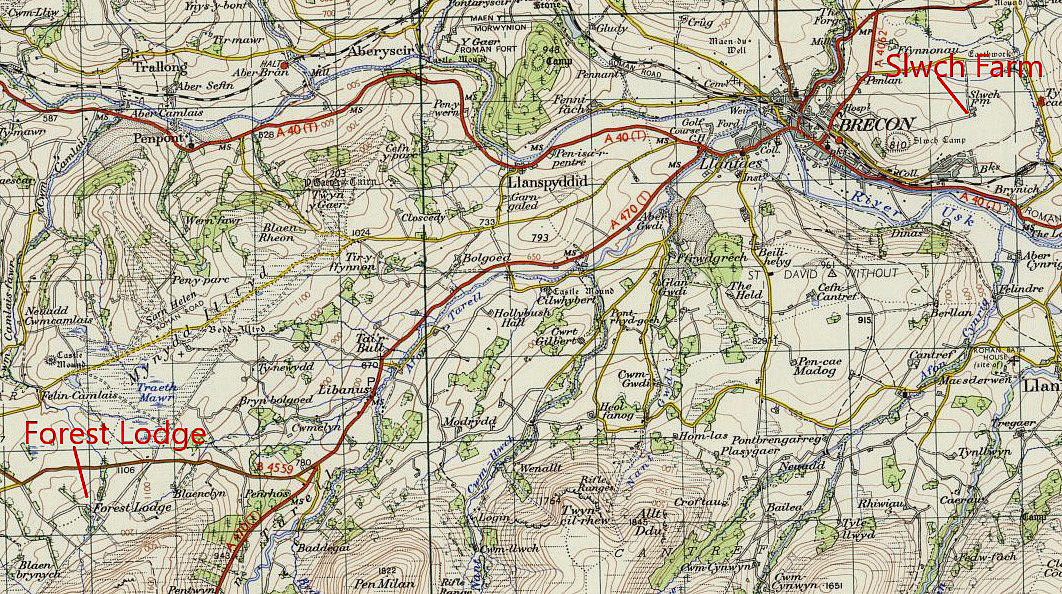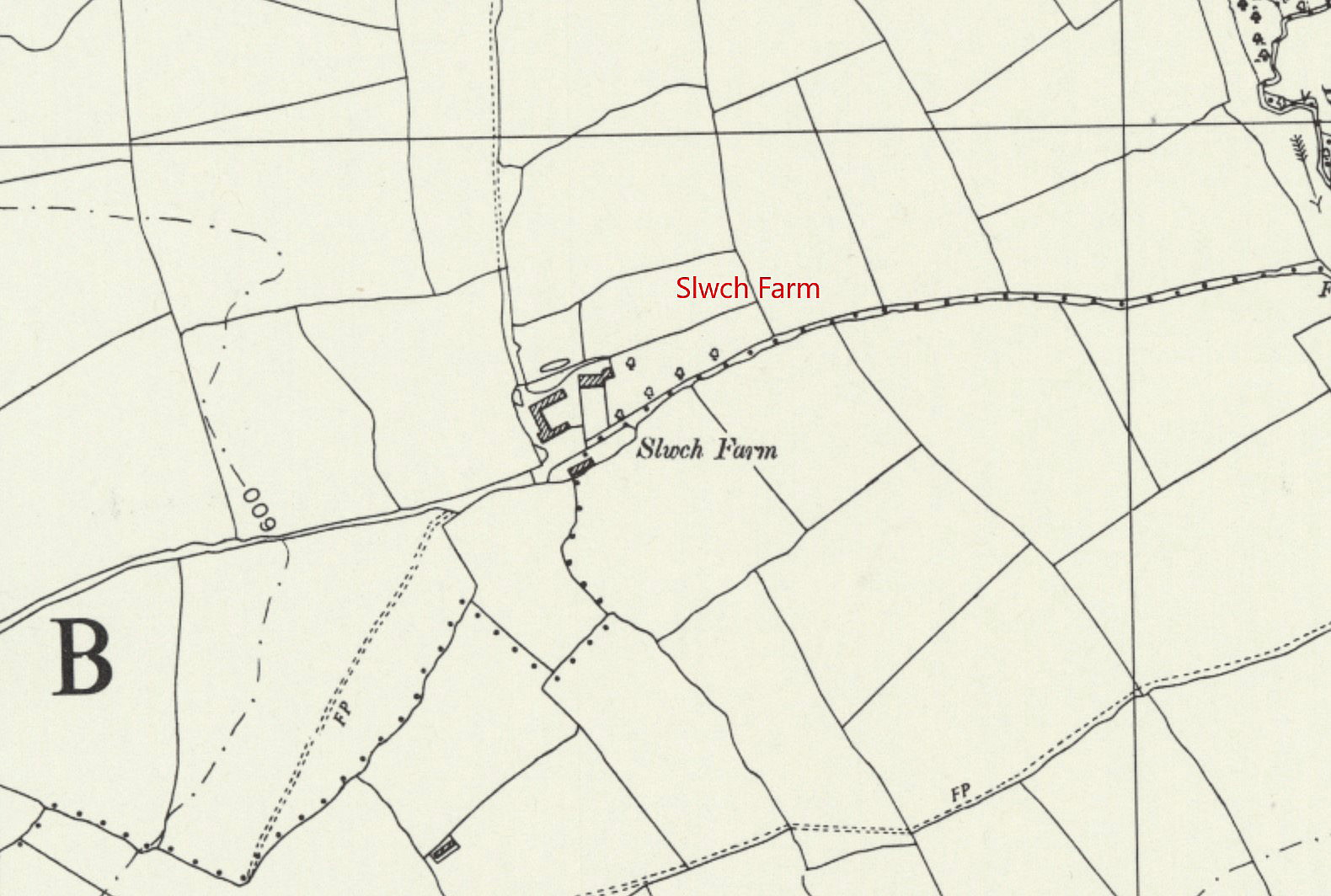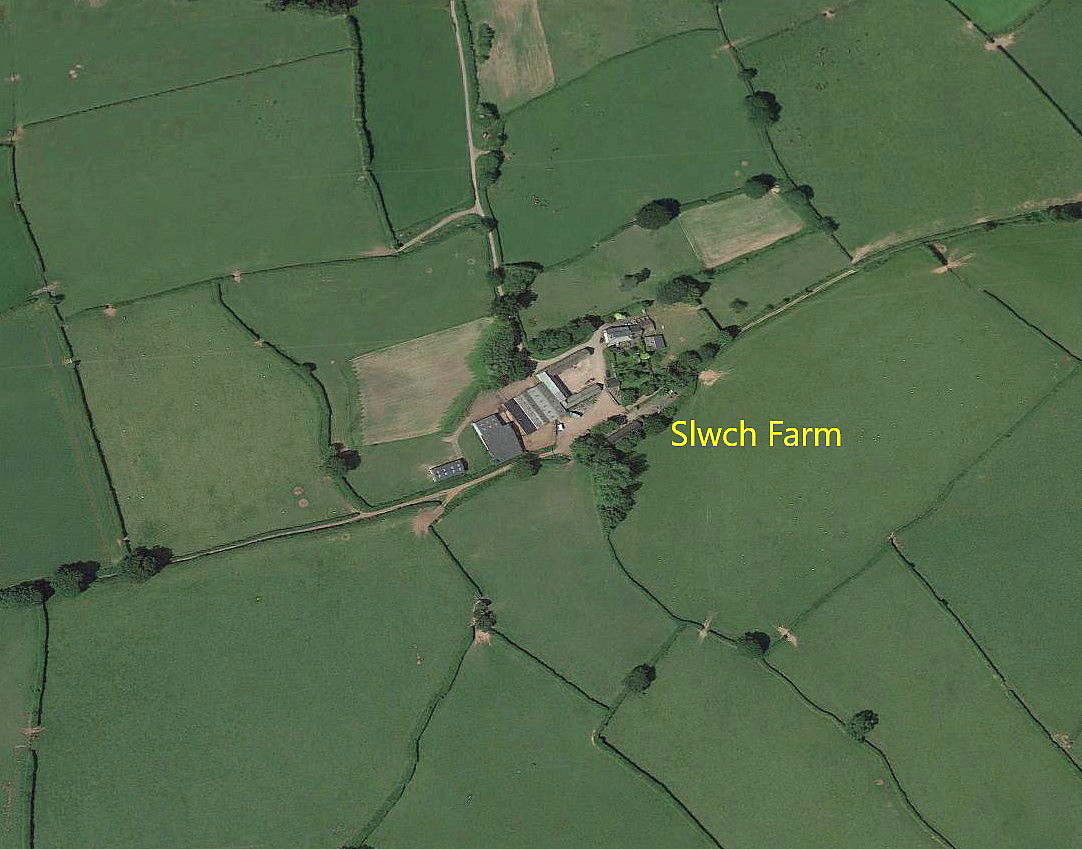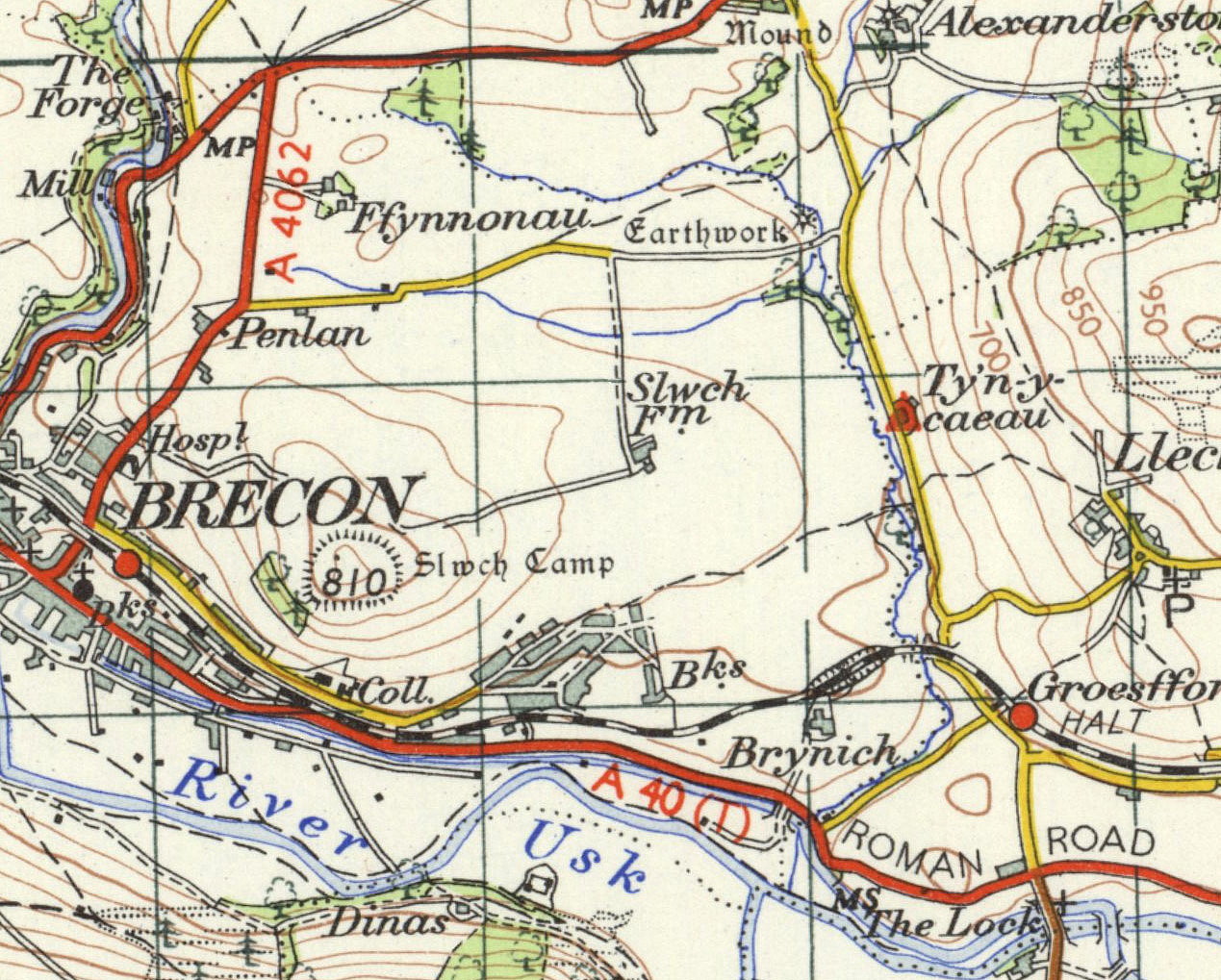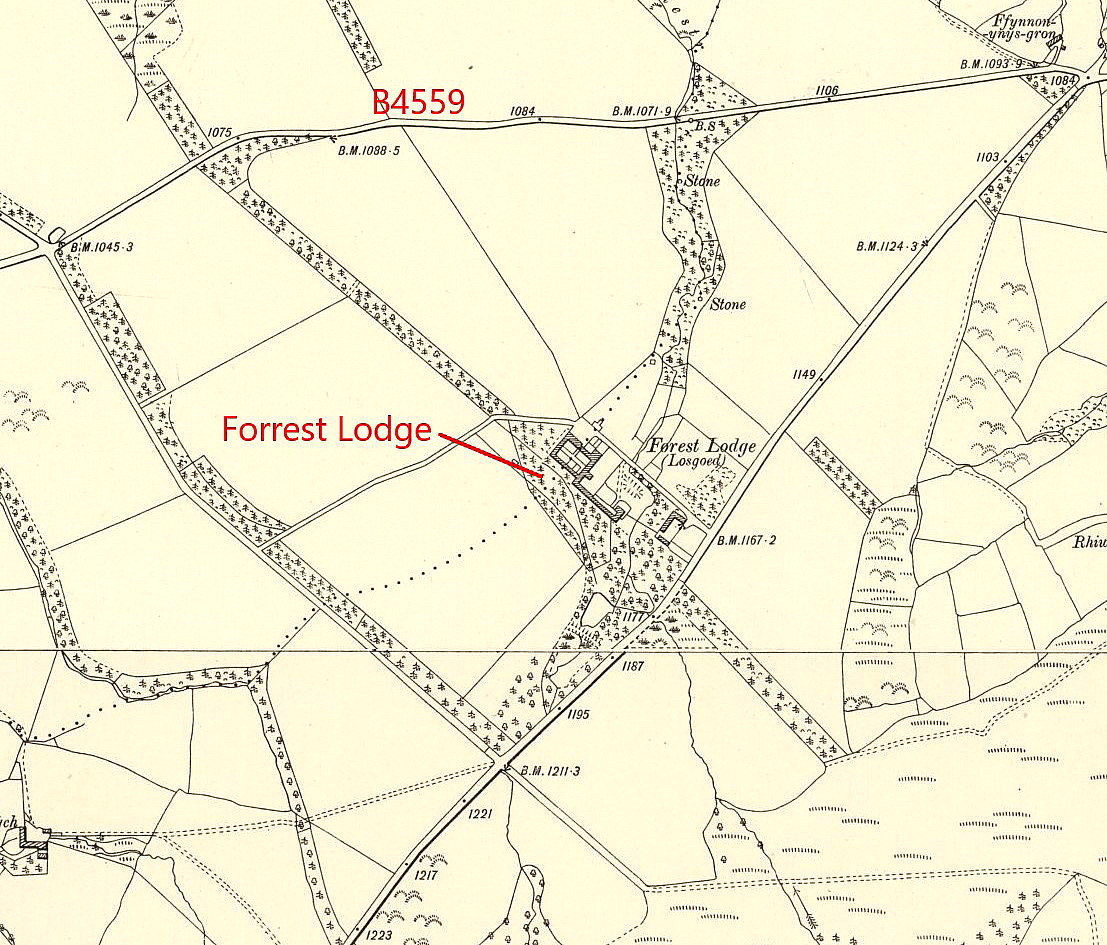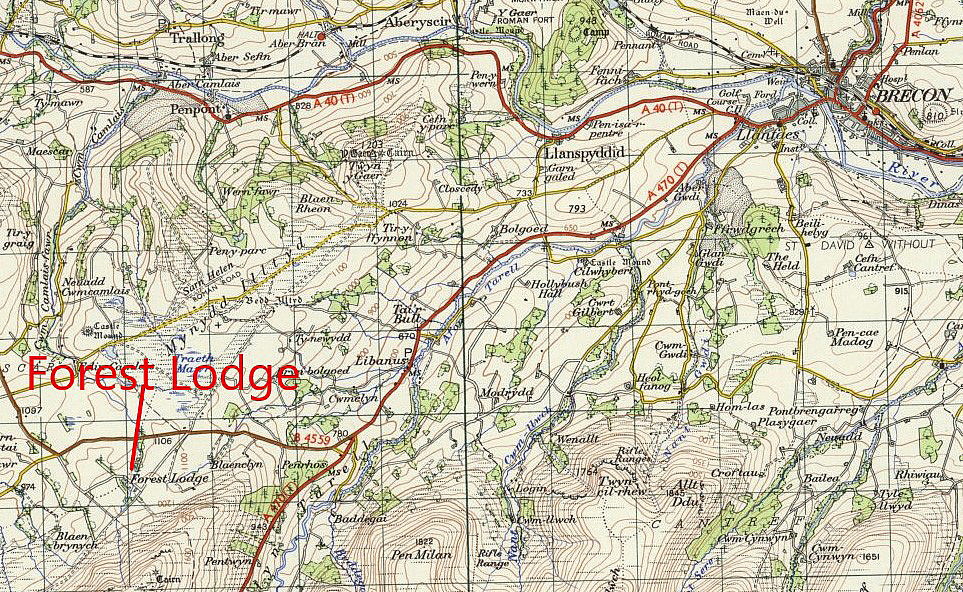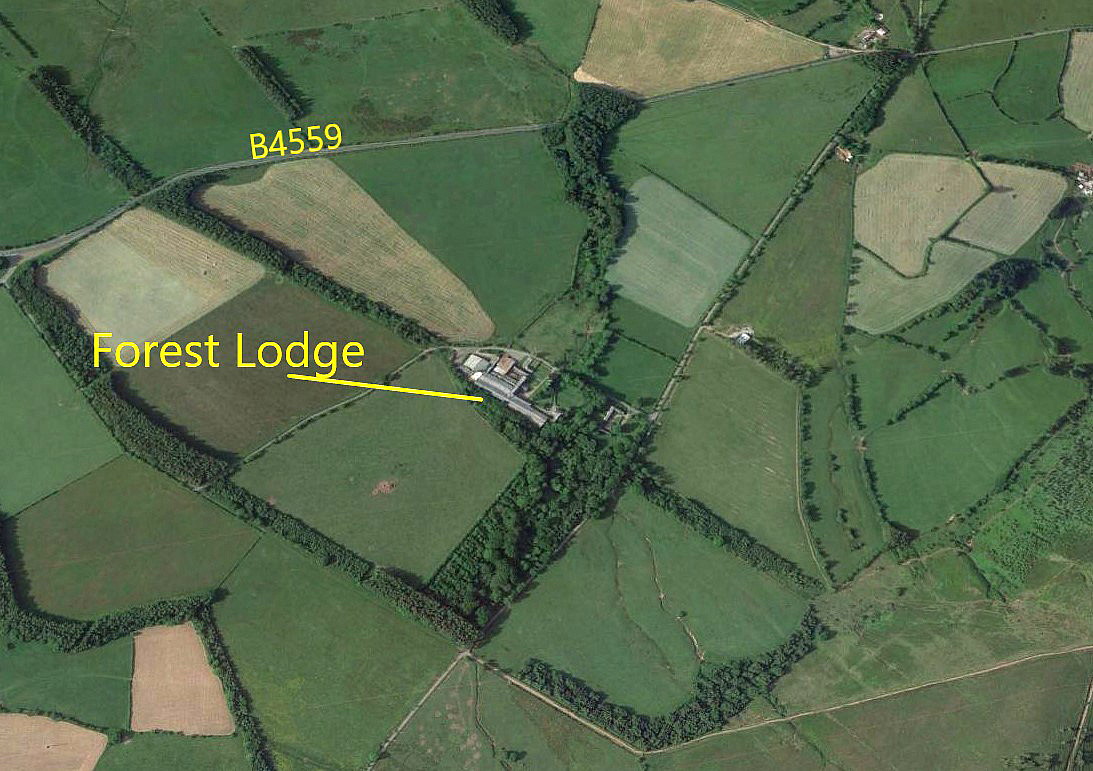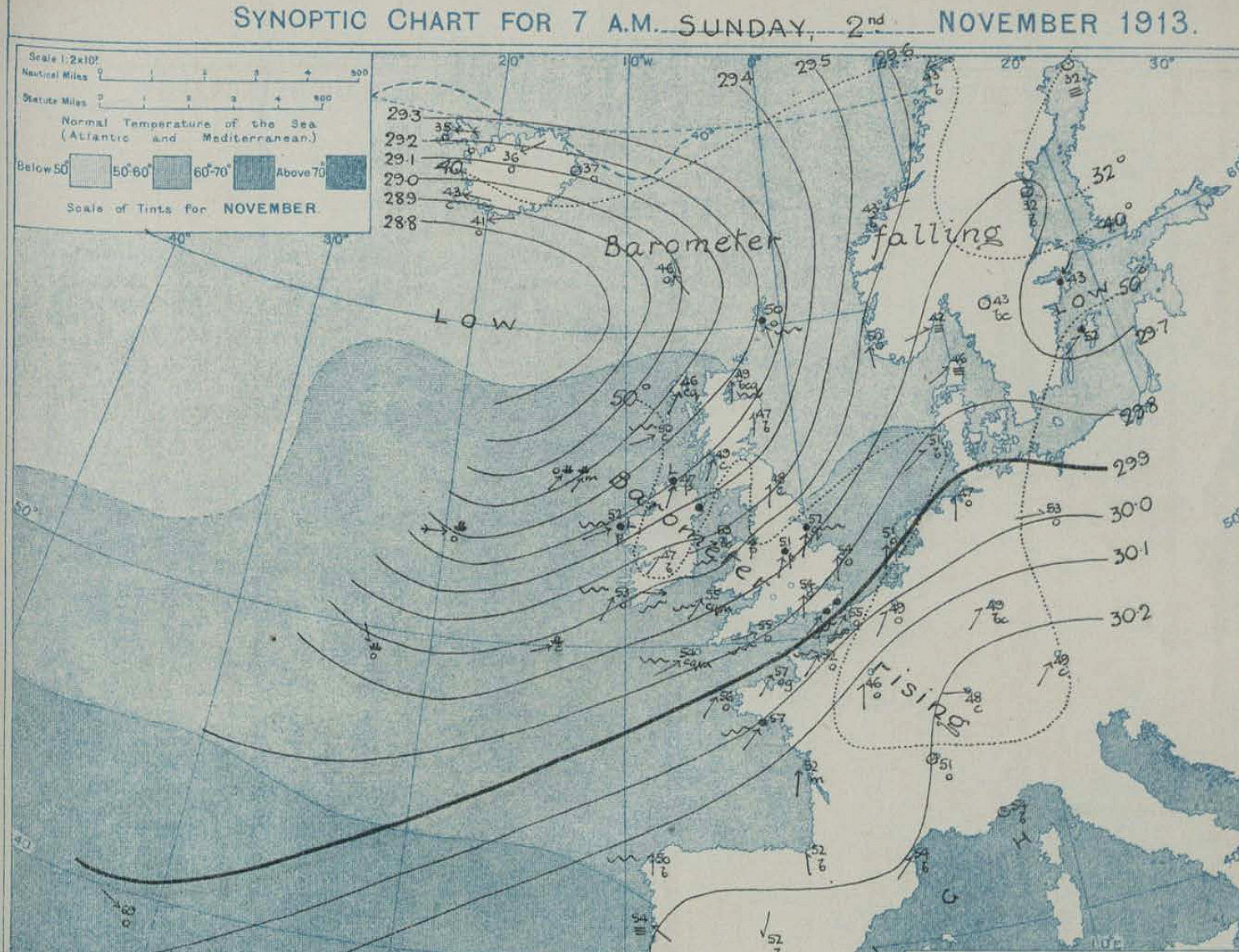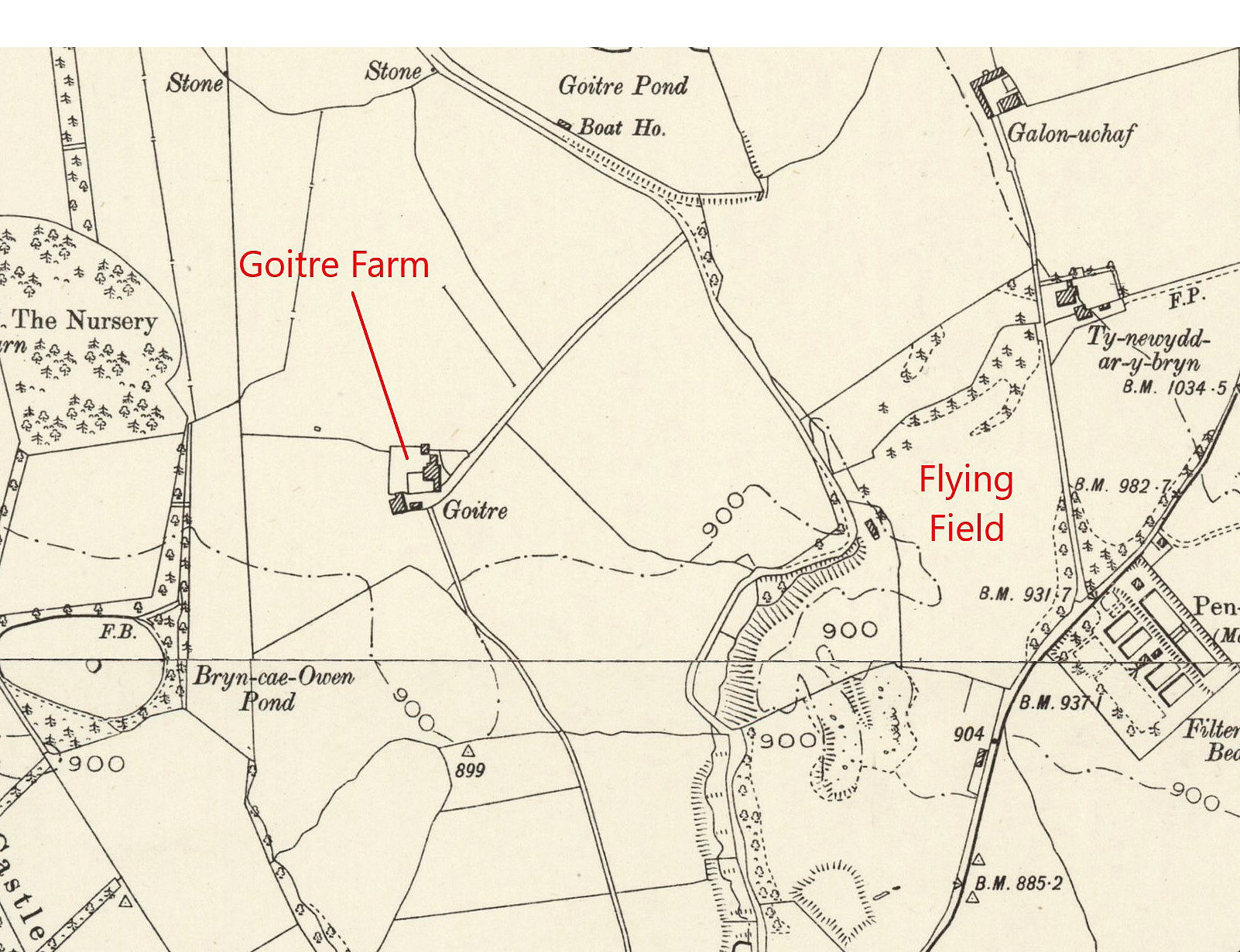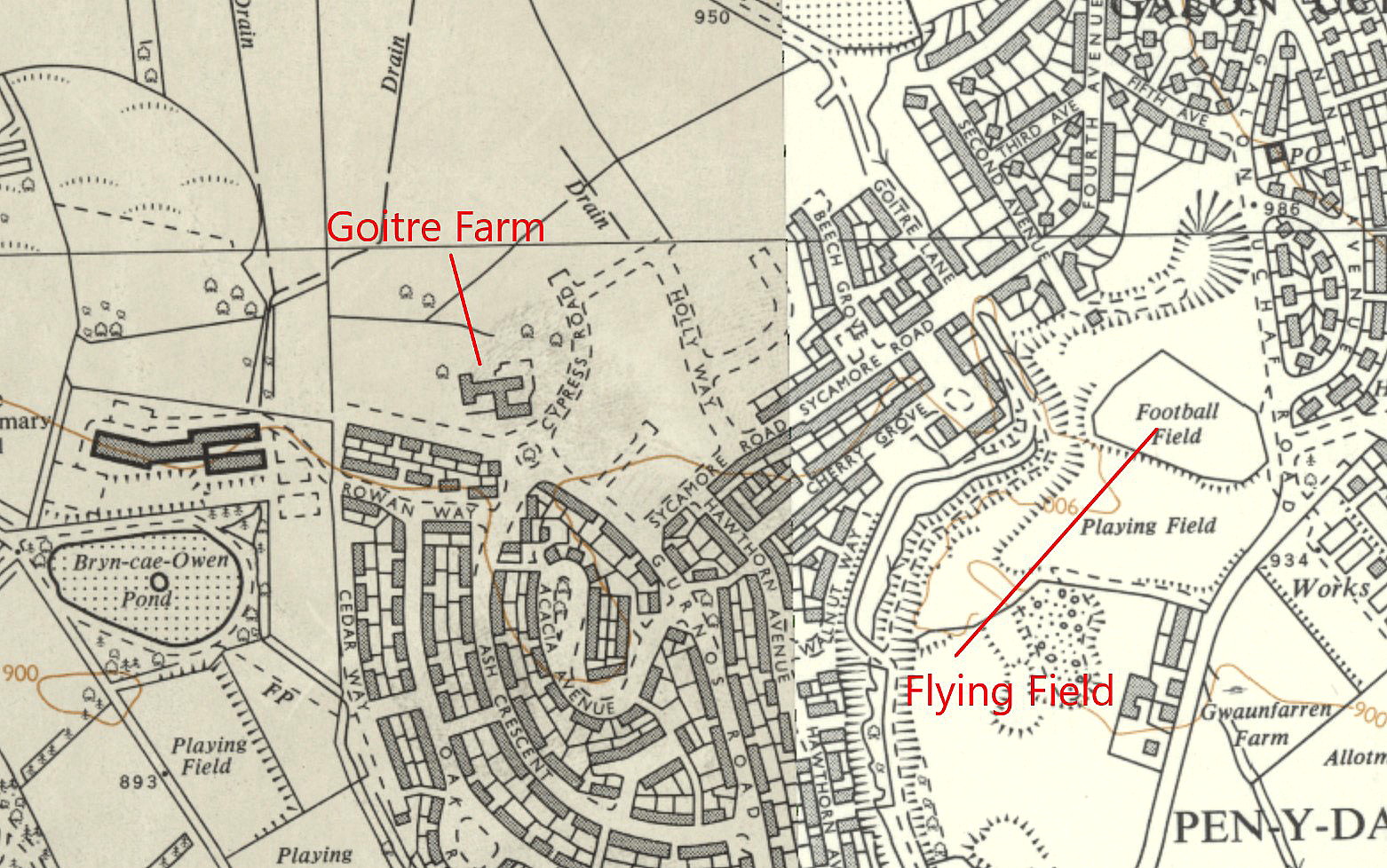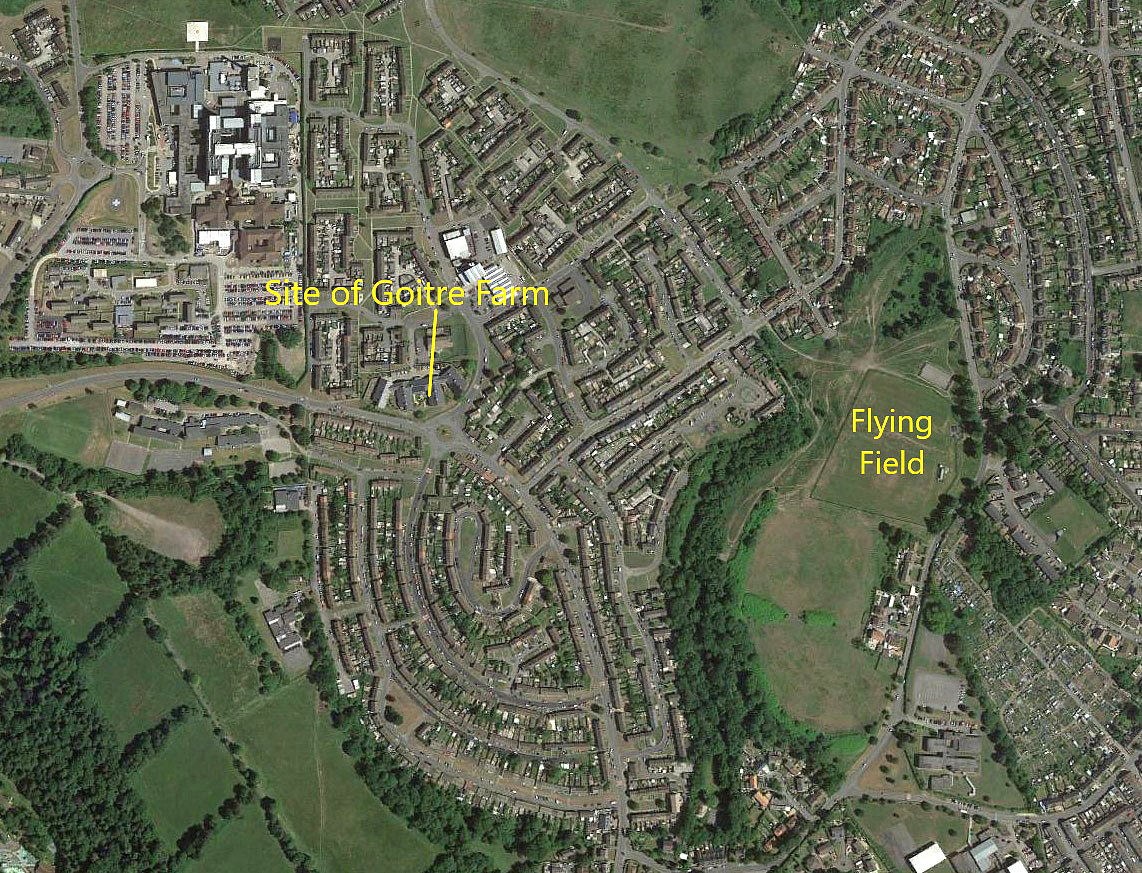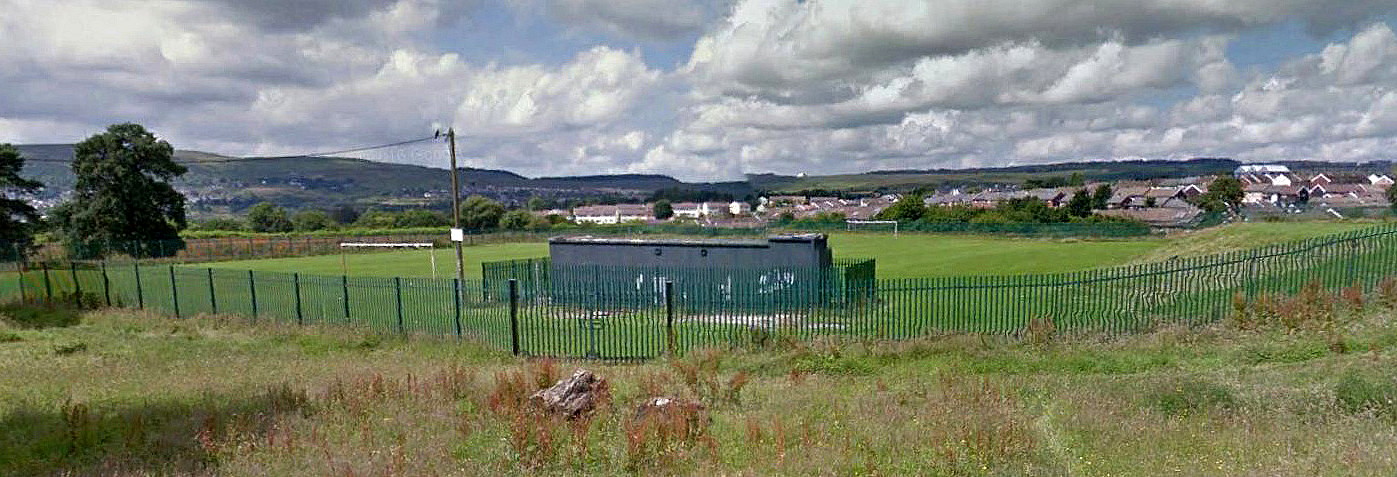Brecon District flying sites 1913
Note: This map shows the position of Brecon town
BRECON & DISTRICT FLYING SITES: AMMANFORD, ABERNANT LAKE HOTEL, FOREST LODGE, SLWCH FARM and GOITRE FIELD, MERTHYR
Edwin Prosser's ambitious flying exhibition tour in late October and early November 1913.
NOTES: This is another fine example of two very good friends of this 'Guide' coming together to provide evidence of an aerial endeavour in 1913 which, I suspect, very few are aware of today? Mind you, this entry is still a work in progress, and will probably remain so for some time to come - perhaps, indeed, for ever. But, we are making progress.
In November 2020 Graham Frost sent me this information:
'Saturday the 25th October 1913 was the day that a well known aviator named Edwin Prosser flew the first aeroplane over Cwmamman. The 30th October edition of the Amman Valley Chronicle amusingly reported':
"Every vantage point was thronged with people watching the first aeroplane flying through the district and, of course, like most other things, it went to Ammanford."
A week later the nineteen year old Edwin Prosser took his 50 hp Caudron biplane to Brecon, where he landed at SLWCH FARM. He flew over the town, (Brecon presumably?), the following day.
First two pictures: Copyright © Powys County Council and Brecknock Museum & Art Gallery.
Note: Mike Holder has arranged permission for these two rare and lovely pictures to be used in this 'Guide'. He also provided the Google Earth © based view of the site.
Graham Frost also tells us that Edwin Prosser was born at Wolverhampton on the 14th April 1895 and obtained his Royal Aero Club Aviator's Certificate from Hendon Flying School in June 1913. He later moved to Australia where he trained others to fly aeroplanes.
MY COMMENT
It seems quite remarkable today that anybody with such very little flying experience would even contemplate, four months or so later, undertaking a project like this. But, what we don't appear to know, is where he departed from. It was far from unusual in those days for pilots to transport their aircraft by rail if long distances were involved. These machines could be easily assembled within a day, with a rigger and mechanic.
Later information leads us to believe that Prosser was then based in Cardiff, most probably at ELY RACE COURSE which was used for flying, and Prosser was due to enter an air race from ELY RACE COURSE to Swansea. However, his aircraft became u/s (unservicable), and he had to withdraw.
What also seems, perhaps, something of a mystery, is why Prosser selected this area to hold his flying exhibitions? The most obvious answer, I suppose, is that all the best venues had already been snapped up by others, such as the super-stars Henri Salmet and Gustave Hamel.
Graham also told me that try as he might he could not find the SLWCH FARM site. So, time to call on Mike Holder, an ex-RAF navigator, and a quite extraordinary genius when it comes to maps and mapping. Mike is also very expert on tracking down newspaper reports. Lo and behold, in next to no time he had the answer and much more besides.
Note: These two maps and the Google Earth © aerial detail were kindly provided by Mike Holder.
Mike also found this report from the Brecon County Times:
AN UNUSUAL VISITOR
"Much excitement was occasioned in Llanwrtyd on the afternoon of Friday last, (my note: Friday 31st October), when a bi-plane was seen approaching the town, heading for the Abernant grounds. In a short time a large crowd, filled with curiosity, had reached the Lake Hotel, where they found Mr E Prosser, the noted Birmingham airman, had safely landed from his Cauldron bi plane. (My note: It was of course a Caudron type). It appears that Mr Prosser, who was on his way from Ammanford to Aberdare, had lost his bearings, and suffering somewhat from the inclemency of the weather, decided to descend, and on reaching the hotel was made comfortable and entertained by Mr J T Evans J.P. "
My comment: We do need to remember that in those days, aeroplanes or 'machines' as they were usually called, had no flying instruments worthy of the name, and he definitely didn't have a compass. So getting lost, fairly quickly without any knowledge of the major features of the terrain, was very much a constant risk. In this case it appears, after departing from Ammanford, he pretty quickly settled on a course at a right angle, (heading NE), to his original intention to fly, more or less, ESE to Aberdare.
GETTING GOING ONCE MORE
"At half past four, much refreshed and in high spirits, Mr Prosser took to his seat in the biplane, and, as if by way of a "good-bye", made several circles of the hotel and grounds, then making directly over the village of Cefn Gorwydd, he was last seen at a quarter to five, a small black speck hovering over the Eppyant range on his way to Aberdare. We understand, however, that owing to heavy showers the airman was obliged to come down again somewhere near Brecon."
My comment: Once again, shortly after getting airborne, Prosser soon lost his bearings.
Mike also found a very detailed account of the flights in this area from the Brecon County Times published in Thursday the 6th November 1913. From which he gives us this account:
"About 5 o'clock on Friday 31st October 1913 the locals at Brecon heard a buzzing sound in the air. Looking up they saw an aeroplane travelling eastwards from the direction of Llanwrtyd Wells towards Abergavenny. The airman just made it past Brecon before bad light made him descend at Slwch Farm. It was the young aviator Edwin Prosser - 19 years old - on his way to Aberdare to give a flying exhibition on Saturday. He started from Ammanford on Friday at 12.30 and arrived at Llantwrtyd Wells at 13.00. At 16.30 he left Llantwrtyd Wells and ascended to 5000ft and encountered a severe storm but made it through, (as Mike says - lucky boy!), to Slwch Farm."
My note: Without much if any doubt Prosser did not encounter a "severe storm". Far fom it, in fact just some quite typical local turbulence created by a brisk breeze. This said it would appear he was flying a Caudron Type F, which first flew in early 1913, and was probably the 'hottest' machine around at the time. Claimed to have a top speed in level flight of 62mph, this contrasts with, say, the popular Bristol 'Boxkite' of three years earlier which could barely manage 40mph. That airspeed of 60 mph easily creates quite severe handling problems in, as said, just a stiff breeze.
"On Saturday morning about 400 people trekked up to the farm, and paid a small admission fee to enter the field where the aeroplane lay; the object of the payments were to compensate the farmer for damage to his property. (As Mike says, an early example of paying landing fees). A rumour had circulated that Mr Prosser would give a short display, and sure enough at 10.00 Mr Prosser got his machine into position and made a fine ascent. He circled round the district for 4 or 5 miles and after 10 minutes made a graceful descent, (or landing as we would say), and was warmly applauded by the large number of people who had gathered round the area."
We today need to remember that without much if any doubt, most if not all of the people present, had never seen an aeroplane, let alone one flying!
"He then refuelled and took on some oil before taking off again just after 10.15 for Aberdare." As Mike points out, on a course of about 185°, and 16.3 miles away. "Mr Prosser ran into thick cloud approaching the Brecon Beacons and had to turn back and landed near Forest Lodge."
Note: Mike Holder has kindly provided these two maps and the Google Earth © picture
Here it appears: "....he received hospitality from Mr and Mrs W S Miller. The bi-plane was left in an open field near the farm and Mr Miller drove Prosser to Brecon. Since Prosser was due in Aberdare at 1500 he secured a large motor car at Messrs H C Rich and Son's Garage. As Prosser and his party reached Forest Lodge a gale sprang up and the wind carried the machine about 40 yards. (My note to younger readers - about 36 metres). "....it was as much as the party could do to hold it down. As time went on the gale increased up to speeds of 60 mph. The machine was pushed to the end of the field facing the wind, but so strong was the storm that all attempts to fly were abandoned."
My note: It certainly wasn't always the case, but by and large the unexpected arrival of an aviator on their property was treated in much the same way as people today might react if a major rock star, very famous actor, or any top of their fame celebrity knocked on their door. Seeking help.
"The machine was pushed by the party, now assissted by a Mr Arnold Coppage, a quarter of a mile into a place of shelter. Rain fell in torrents for about 2 hours before it ceased. The wind remained strong and squally , but Mr Prosser resolved to make another attempt to get to Aberdare." As Mike Holder quite rightly says, this can be called 'Pressonitis' and many have suffered from this maliase, and still do, often with fatal results.
"Taking the bi-plane to the other end of the field, he rose 20ft into the air, but a sudden squall of wind caused it to dive towards the ground where Prosser managed to control the "crash" to the extent there was no serious damage to the aircraft. The aircraft was again secured and Prosser abandonded flying again and returned to Brecon and took up his quarters at the Wellington Hotel."
My note: Prosser had no idea about what he was trying to do. He was clearly brave and very foolhardy, and very lucky to survive. But, in those days every pioneer aviator was pushing the limits to find out what might be achieveable. In WW1 of course, just a year or so later, with so many lives lost in the process, the learning curve about flying went up nigh on vertically. But of course, still in its infancy. So much more still to be learnt. It is probably fair to say that it wasn't until the 1960s and 1970s before the real science of aeronautics became established.
A SYNOPTIC CHART
Mike Holder has managed to unearth this synoptic chart from the 2nd November 1913. And offers us this explanation:
"It shows a deep low to the north west of the UK tracking easterly with returning polar maritime air covering the south of the country. This type of airmass has stable air at low level but unstable air generally above 2000ft which would account for the severe storms over the Welsh mountains. Looking at later charts, similar conditions lasted for the next 3 to 5 days which stopped Prosser flying."
Quite why Prosser decided to undertake a tour in South Wales at that time of year will be very hard to understand. But, as said above, he was nineteen, headstrong and foolhardy. As I expect most of us were at that age. It certainly seems that he escaped serious injury and even death more from luck than judgement. But, this last stage from Brecon to Merthyr defies belief and, by todays standards most private pilots would regard it as being suicidal. The only extra comment I can make is that, presumably, his Caudron was a very stable machine.
BRECON TO MERTHYR
All six of these maps and pictures were kindly provided by Mr Michael T Holder
Precis of accounts in local newspapers by Mike Holder.
"Edwin Prosser was due to display at Goitre Field - Old Football Ground - on Thursday 06 November 1913."
"On the Thursday- 6 November 1913 - a flying machine was observed at the northern end of the town - Merthyr - and it landed near the Goitre Farm. The weather was bad and few of the public had turned up. Mr Harry Green of Park View, was the person who had arranged the aviator's visit and when he heard that a flying macine was hovering over the town he said "This is my man", and in the teeth of a terrible storm, he walked up to the Goitre Fields in time to welcome the intrepid airman who he found at the farm; there was considerable excitement owing to the fact that the "man" had landed in the wrong field and had to fly again to the correct field. Mr Green found the airman suffering very much from the cold and severe weather that he had passed through on his journey."
My note: If young, very fit and fired up with ambition, the ability recover really can be remarkable.
"On Friday an exhibition of flying was given by Mr Prosser. The weather was dull, but no rain fell. He made several flights and the easy graceful way he managed the machine was wonderful. There was a fair attendance of the public, who enjoyed the novel sight very much. Those responsible for the business arrangements had, however, not allowed for sufficient time for the event to become known, or there would have been a greater crowd present on the Friday afternoon."
My note: Prosser was a complete amateur and clearly had some idea of the potential such events could have, but no concept of the amount of organisation required. By contrast the real professionals of that time had quite a team involved, and indeed, such was the prestige associated with these 'super-stars' many towns declared a public holiday! I cannot recall, for example, any major rock stars being granted that privilege. Indeed, the next best thing to a Royal visit.
"At an interview on Friday evening with a newspaper reporter, Prosser revealed he left Brecon on Thursday 06 November at 15.30 and arrived at Merthyr 20 minutes later after a very trying flight over the Brecon Beacons. When he left Brecon the weather was fine, and he flew at 400ft but then he had to dodge a heavy bank of cloud by diving under them. Then he saw looming ahead the frowning Beacons which he mistook for clouds. When he realised it was not cloud, he ascended to 4000ft at which altitude he encountered a severe snowstorm, with huge flakes of snow which covered his goggles and blotted out everything from sight."
My note: Is this something I need to learn? I thought snowflakes were consistent in size? Having flown through snow showers and driven through blizzards, I think the effects are purely a result of the density of the snow.
"He decided to reduce altitude and try and locate himself and get a glimpse of the earth." (As Mike says - 'How many times has that cost a pilot his life?). "As he descended, he ran into a fierce hailstorm, (Mikes note CuNb or large Cu - Ouch!), so severe it cut his celluloid goggles and beat his face into a painful state. When he landed his face resembled a piece of raw beef. He found the short journey from Brecon a somewhat trying ordeal. (As Mike says - 'Understatement of the year'). He was also soaked with rain."
My note: It never ceases to amaze me just how far we have come in aviation. Watching airliners taking off into similar conditions is still a wonder to me. Plus of course, for military pilots virtually no kind of weather can prevent them from flying.
"The method of signalling to airmen where to land was by placing strips of white sheeting in a 'V' shape on the ground. This was not done at Goitre Fields. Yet Mr Prosser, although he had not been there before, was able to locate the ground and alight within a field or so of the arranged landing place. When asked how he did it he replied; "By intuition" having been previously told the direction and locality."
My note: This of course makes no sense. Just a few days before he had completely lost his bearings and headed off in totally the wrong direction. But, perhaps, he was starting to learn that preperation for navigation really was vitally important?
"Hundreds of people visited the field on the Saturday, but there was no flying. It was stated that there was a mechanical fault on the machine. What the public naturally asked was 'Where is the mechanic to fix it?'. And why was the defect not discovered until 16.00. The public had been kept waiting on the damp field: hundreds had given up watching a football match to see the flying. Apparently Mr Harry Green - one of the promoters - had gone into town to find some special wire."
What a great insight into those early days. One small aspect that interests me is how did Prosser gauge his height? The first reliable altimeter was produced in 1928 but other much more basic devices were available long before, but giving results with errors up to +/- 400 ft or more. Perhaps Prosser had one of these devices fitted to his aircraft?
We'd love to hear from you, so please scroll down to leave a comment!
Leave a comment ...
Copyright (c) UK Airfield Guide















